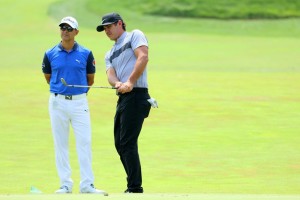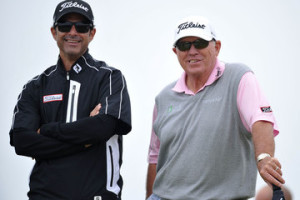Claude Harmon III comes from the first family of golf instructors. His dad Butch, his grandfather Claude and his three uncles, Craig, Dick and Billy have all coached the world top golfers.
Claude III has come into his own with prized students like Brooks Koepka and Dustin Johnson. Harmon opens up in this months Golf Digest with some interesting info on his dad, grandfather and of course Tiger Woods.
He says no one can let things go like DJ:
DUSTIN IS THE POSTER CHILD for everything sport psychologists recommend but what nobody is really able to do. After he three-putted the last hole at the 2015 U.S. Open at Chambers Bay and lost to Jordan Spieth, we all knew he’d be crushed. An hour later, I was in the garage of his rental house, loading up the cars to go to the airport. Dustin came out, looked at me and smiled. “I played so [bleeping] good today,” he said. And that was it. He never mentioned it again, at least not to me.
His proudest moment came with his pre-final round advice to Koepka:
MY FAVORITE COACHING MOMENT came with Brooks. He began the final round of the U.S. Open at Erin Hills one shot out of the lead. Brooks might not be a golf nerd, but he knew this could be the defining moment of his career. In a moment like that the tendency is to play the way others think you’re supposed to play—tactical and a little guarded. That is not the way you want Brooks Koepka to play golf. Just before he left the putting green to go to the first tee, I locked him in. I told him, “Today you are going to be aggressive. Whatever happens out there, play your game. Be you.” Man, was he ever him. You saw the power, the freedom, the fearlessness. He birdied the first two holes. On the back nine, he grabbed the golf course by the throat, made three birdies coming in to win by four. I was so proud of him and took a lot of satisfaction knowing that my message to him was the right message.
Tiger showed up at Butch’s when he was 17 and just starting to take on the world. They were blown away:
WE CALL IT “THE VIDEO.” It’s a VHS tape, time-stamped Aug. 23, 1993, of the 17-year-old Tiger Woods taking his first-ever lesson from my dad. Tiger and his father, Earl, had driven up to Lochinvar Golf Club in Houston after Tiger lost in the quarterfinals of the U.S. Amateur at Champions Golf Club, which is nearby. My dad was teaching Greg Norman at the time, and Greg had just won the 1993 British Open, so Tiger and Earl thought they’d listen to what my dad had to say. I was 24 and just starting out, helping my dad where I could, learning to teach, running video and closely observing his lessons. The three of them were talking, and suddenly Tiger decides to hit balls. My dad was cool on the outside, but inside he was excited. He whispered to me, “Get that video camera going, now.” Tiger was just a skinny kid. He didn’t even have a glove with him, just his clubs and a beat-up pair of golf shoes. What Tiger did that day was historic, the first view of what he could do. The clubhead speed, the sound he made at impact, the ball flight, was unbelievable. Watching Tiger, my dad was quiet for a long time. Tiger was hitting 8-irons so unbelievably high and far, I think my dad had trouble picking up what his clubhead was doing through impact. It was just a blur. You never see Butch Harmon puzzled, so this was a first. When Tiger switched to driver, forget it. More silence from my dad, followed by a very good question: “What’s your philosophy when you swing that club?”
TIGER SAID, “I know I hit it farther than everybody, but not always very straight. I just hit it and go find it.” It didn’t seem like a great philosophy at the time, but Tiger was exactly the prototype of what the best teachers are looking for now. Give me 15 juniors, and I’ll take the one who can’t hit the range, he’s so crooked, but who has speed and strength to burn. You can teach a player to hit it straight and to repeat. You can’t teach speed.
AFTER THE LESSON BROKE UP, we didn’t know if my dad would become Tiger’s teacher. On the drive home he was quiet again, lost in thought. I said, “So what do you think?” He said, “I don’t know if I’ll get the chance, but if I could work with that kid, I’ll make him the greatest player the world has ever seen.” One thing that impressed him was, he would tell Tiger to hit a shot he knew he’d have trouble hitting. Tiger would say, “I can’t hit that one, but if you show me how, I can do it.” My dad would give him a thought and a feel, and bang, Tiger would hit it. No matter what it was, he brought it off, first try, on command. Tiger was the kind of blank canvas that comes along once in a lifetime, and my dad knew it.
He recognizes the differences in today’s younger players as they hang out together and seem more apt to pull for each other than go for their throats:
WHEN JORDAN SPIETH WON THE BRITISH OPEN, he had six players waiting for him to finish so they could fly back to the States together. Can you imagine Tiger, Vijay, Ernie and Phil waiting for one of the others to finish so they could do that? The relationships between Dustin, Jordan, Justin, Rickie and Brooks are much friendlier, and although they might lack a certain Darth Vader-versus-Luke Skywalker drama, it’s healthier. The Europeans figured out years ago that being friends was a better way to go, especially when it came to the Ryder Cup. Over the next 10 years you’re going to see some amazing Ryder Cup performances from the Americans. Europe is facing a real problem because they’ll be playing against guys who from top to bottom truly have each other’s backs.
He found his niche as a teacher not a player:
I NEVER DID BECOME A GOOD PLAYER, although early on I did try. It’s led to some skeptical looks. But I’ve always felt there are ways it has worked to my advantage. For one, I truly know how hard golf is. I can relate to the struggles. I never ask a player to perform some crazy-difficult movement that teachers who are good players sometimes assume anyone should be able to do. I don’t try to make them swing like I do, which would be a disaster. My job is to teach golf, not play it, and I spent a lot of years studying closely as the best teacher in the world—Butch Harmon—taught Greg Norman, Tiger Woods, Steve Elkington, Davis Love III and so many others.
But it wasn’t due to his grandfather:
ONE DAY WHEN I WAS 13, my dad arranged for my grandfather to give me a golf lesson. At the time I didn’t really play golf—I preferred other sports—but who wouldn’t jump at a lesson from Claude Harmon? So I got warmed up on the range at Lochinvar, and up he drove in a cart. He parked it directly across from me, not three feet away, and said, “Let’s see what you got.” His tone made me nervous. I began hitting, and for some reason started shanking. He gave me a couple of quick pointers, but after a few more shanks, he stopped me.
“Do you play other sports?” he asked.
“Yes sir, football,” I said. “Wide receiver.”
He asked, “When the coach tells you to go out 10 yards and turn to the right, what do you do?”
I answered him. He then did a similar thing with each of the four sports I played, asking what I did specifically when the coach told me to do something.
He said, “Here’s the problem: I’ve been telling you what to do for 10 minutes, and you haven’t done a thing I’ve told you yet. My synopsis is, you’ve got no talent, and I’m going to lunch.” With that, he put the cart in reverse and left. After a few minutes of standing there, I walked back to the clubhouse and, in tears, told my dad what had happened.
“Don’t worry about it,” he said. “I’ve gone through that my whole life.”
It seems like the apple hasn’t fallen far from the tree. Butch has had his major champions and now Claude has his.


